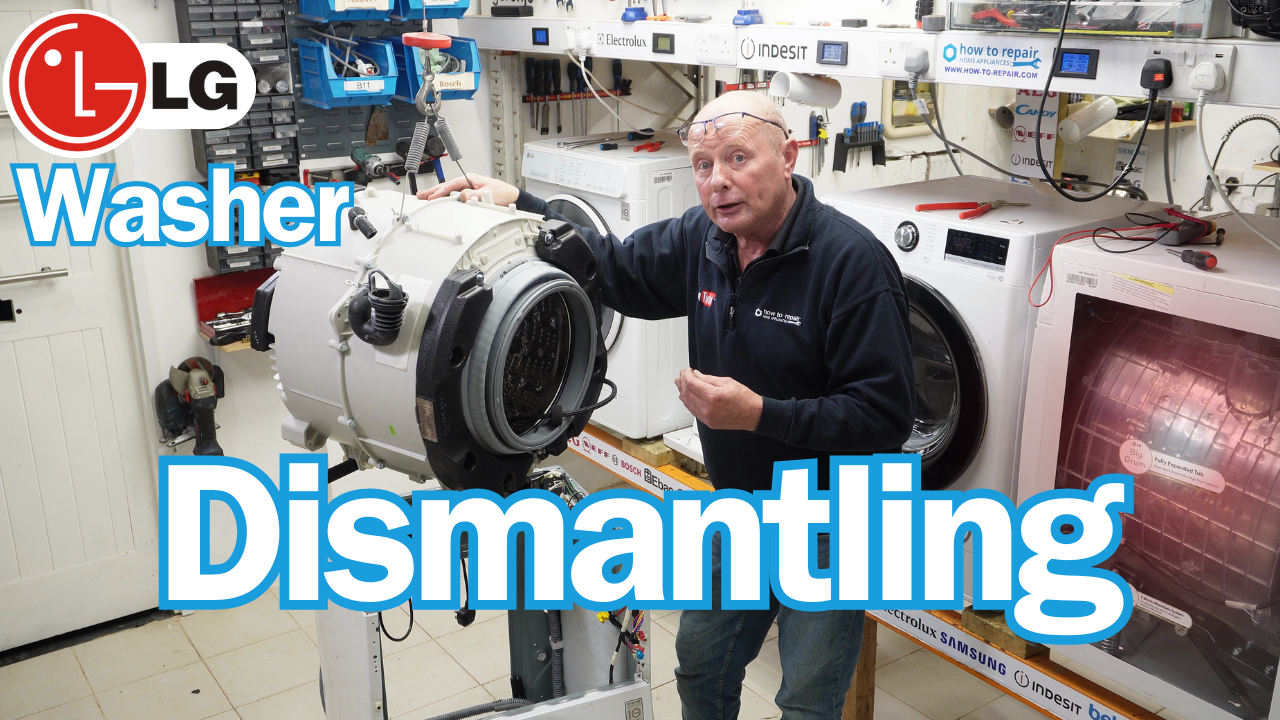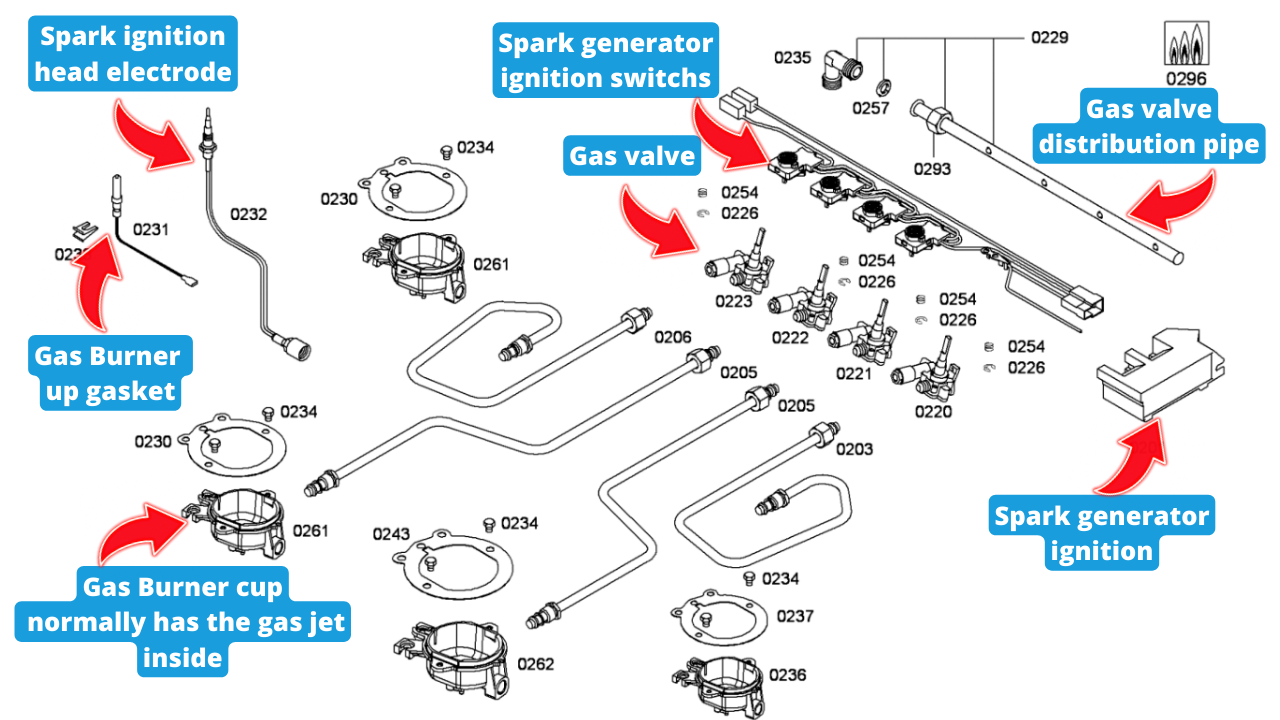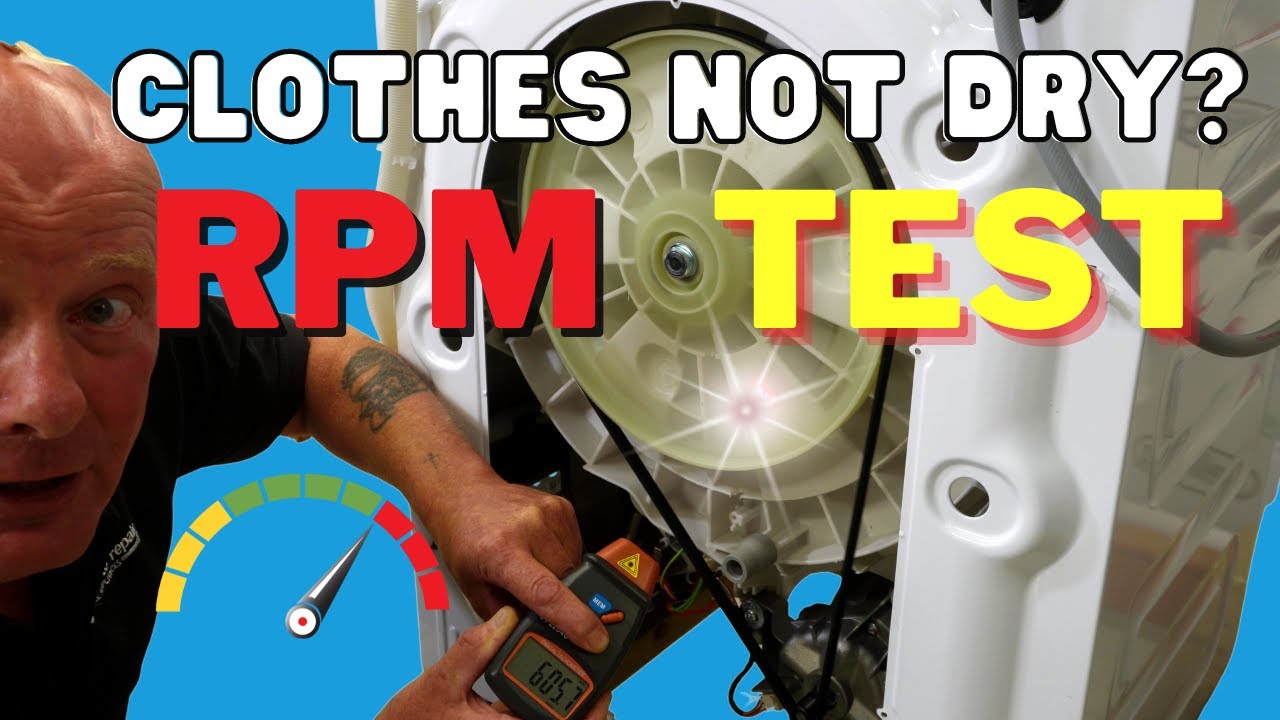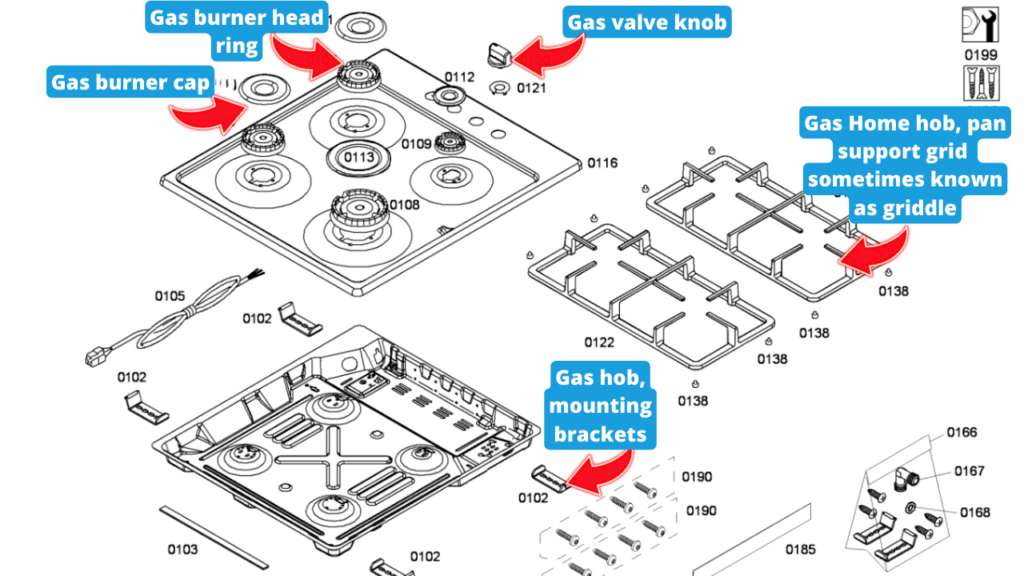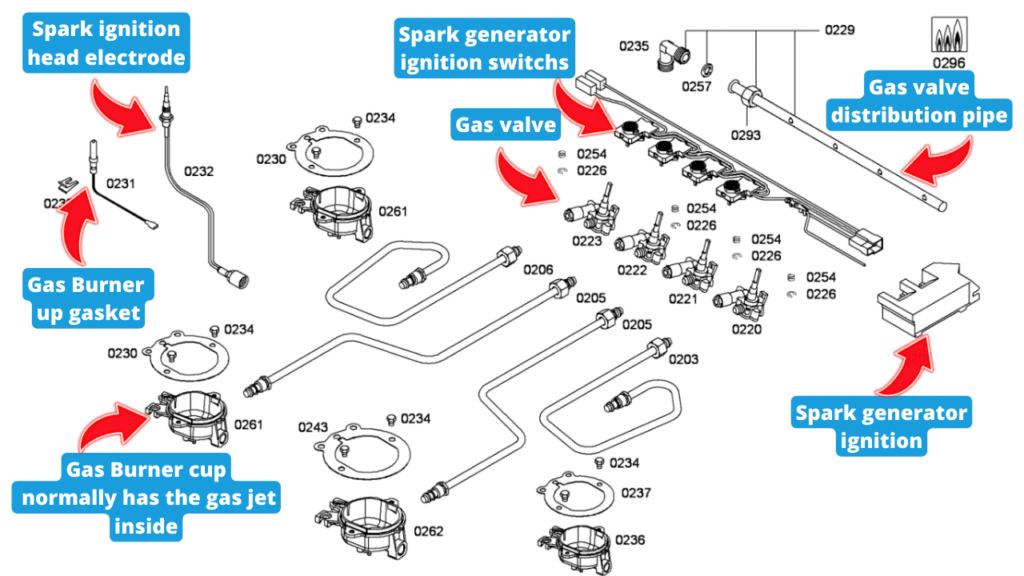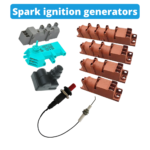Gas hob stove top diagnosing problems and fault finding the complete guide to understanding common faults
Understanding Your Gas Hob
🔥 Understanding the intricate details of a Gas Hob, Range Top, Stove Top, or Gas Burner Top is essential, no matter what you call it in your corner of the globe. It's the key to getting to grips with each component's role. 🛠️ When you know what each part does, you're all set to tackle any issues with your cooker top like a pro.
🎥 In this step-by-step tutorial, complete with easy-to-follow videos, I'll walk you through every part of your Gas Hob. You'll learn about each component's purpose and how it works. Plus, I'll cover a wide range of common problems you might encounter with Hobs and provide detailed exploded diagrams for better understanding. 📚 By the end of this guide, you'll be an expert on your Gas Hob, Top, or Range Top, guaranteed.
🌍 Remember, safety standards vary worldwide. So, before you dive into any gas appliance work, always check your local rules. For example, in the UK, only Registered Gas Safe Engineers have the green light to work on gas appliances. 🇬🇧 Stay safe and informed!
Diagnosing Gas stovetop or cooktop hob problems
This video will show you how to get your flame pattern correct on a gas hob cooker top
Ordering gas, hob or cooker top parts
Ordering the appropriate components for your gas hob or cooker top is crucial. To ensure accuracy, utilise the full model number found on the identification label of the appliance itself. Avoid confusion with any built-in appliances beneath it. For freestanding appliances, simply use their model number. However, if dealing with a separate hob or cooker top, the label is typically located on the unit's underside.
There are over 1 million parts for gas hobs or stove tops so using your model number is very important
🚫 NOTE: when searching for gas parts, you will always need your full model number and brand if you cannot find what you're looking for please use the Contact Us page
🛠️ Homeowners’ Common Questions: Troubleshooting and Repairing Your Gas Hob or cooker top Solutions
🔥 Customer Query: My gas hob's flame is weak, gas uneven or too low, and it doesn't seem to heat food properly.
A possible solution to this issue might be addressing a blocked jet. Low pressure reaching the burner head may result from debris in the pipe system, thus restricting the gas flow. Simply removing and cleaning the gas jet, as demonstrated in the accompanying video, might resolve the problem. The gas burner head may also need cleaning.
💡 Customer Query: Why won’t my gas hob ignite? Gas Stove Top Burner Not Lighting.
An issue may arise from insufficient or no gas reaching the burner head, or perhaps a spark system malfunction. Should a spark ignite beside the burner, it suggests a lack of gas flow. Conversely, a missing spark could indicate a problem with the spark electrode or generator. Occasionally, the spark switches connected to the gas valves may also cause complications.
🔵 Customer Query: Why is there a yellow or orange flame instead of blue?
Gas Burner Flame Guide.
An incorrect flame pattern on your gas burner can result in various minor issues, such as the accumulation of soot on the base of your pans. This typically indicates that the flame is not burning properly. In the video above, I demonstrate the correct flame pattern, highlighting the significance of an appropriate mix of oxygen and gas.
Insufficient gas can lead to an inadequate flame, while an excessive gas-to-oxygen ratio might cause a yellow tint on the flame, which contributes to soot buildup. Additionally, if a jet does not permit the proper amount of gas to pass through, the burn rate on the burner head will be insufficient, resulting in a yellowing flame.
Occasionally, individuals may have connected an improper gas supply to their cooker top, using propane or butane with an unsuitable regulator for the hob's designated pressures. Ensuring a perfect flame pattern is crucial for cooking; too much gas can also adversely affect the flame pattern.
🔥 Customer Query: Gas burner not staying lit.
Should you find your gas burner remains alight whilst holding the knob down, with the ignition system functioning correctly, yet extinguishes upon release, there could be one of two explanations. Firstly, ensure you hold the knob down long enough for the flame safety device (FSD) to activate. Designed to protect your household from wind extinguishing the flame during cooking, the FSD allows gas to flow consistently without manual intervention once it reaches an adequate temperature. However, gas will continue to flow until the FSD cools sufficiently to cut off the supply.
Secondly, examine whether the burner head is obstructed in any way. In essence, a strong flame must reach the FSD. If both gas and a robust flame are present at the FSD but fail to remain lit after roughly 10 seconds, it may be necessary to replace the FSD. These devices serve as invaluable protection against potential fires or gas explosions within your home.
⚡ Customer Query: Gas Stove Igniter That Doesn't Spark
If your gas igniter fails to spark on one or more hob burners, the issue may lie with the spark generator or a malfunctioning spark electrode. Upon pressing the igniter button, if you hear a clicking noise and some burners light while others do not, this typically indicates a problem with the gas spark electrode, a possible fault in the lead connected to the electrode, or a failing spark generator. It is essential to note that grounding is required for creating a spark, involving a positive and negative or live and neutral connection. If the gas burner head or burner cap is excessively dirty, the electrode may struggle to produce a spark across the burner. Maintaining cleanliness is crucial.
In an upcoming video, I will demonstrate how this system operates in detail. To ignite the gas hob, you either press a button or hold down the gas valve knob until a spark is generated and the gas lights up. Occasionally, dirty switch gear on the gas valve can also cause issues. Ensuring all components are clean is vital as spillages frequently occur on gas hobs. People often overlook that liquids can seep through to electrical components, accumulating a layer of grease over time, which can disrupt the switch system or prevent a spark from reaching the point where the gas ignites.
🔧 Customer Query: The ignition of my gas hob keeps sparking and clicking, is it normal for the igniter to keep clicking?
When the ignition system refuses to switch off, accompanied by persistent clicking and continuous sparking despite lit burners, it typically signifies an issue with the ignition switch. Fat accumulation can cause some switches to remain active when they ought not to be. This is often due to inadequate maintenance and frequent spillages leading to fat buildup.
I advise thoroughly cleaning the area around the electrode and the ignition circuit, which is commonly a switch atop the gas valve. Ensure these components are immaculate. A test may be conducted from the ignition wiring loom, extending to each individual gas valve and ultimately to the spark generator. When activated, the switch sends a spark across to the gas burner; however, if the switch malfunctions, this could be problematic.
Occasionally, a fault may lie with the spark generator, but inadequate maintenance is usually the culprit. The incessant clicking noise whilst cooking can be irritating; therefore, take time to dismantle the appliance and meticulously clean all aspects of the electrical loom.
🚨 Customer Query: What should I do if I smell gas around my hob?
Should you detect the aroma of gas, it is of paramount importance to immediately isolate the gas supply and enlist the assistance of a qualified individual to examine the appliances. Common issues that may arise include leaking valves, ineffective burning at the head due to inadequate maintenance, or potential leakages in pipes, gaskets, and connections. As safety is the foremost concern, I shall refrain from offering excessive advice on this matter.
A gas leak left unaddressed may result in a disastrous outcome; hence, it is crucial to isolate the appliance and arrange for an inspection. Appliances are typically subjected to pressure tests to ensure no pressure loss transpires while all gas valves are closed. A decline in pressure under these circumstances signifies a leak.
Employing specialised gauges, I attach them to gas tops and monitor for approximately 20 minutes to verify the absence of pressure drops. Should a drop in pressure occur, this implies a gas leak that necessitates prompt resolution.
🔥 Customer Query: Why does the flame go out when I release the knob?
Upon releasing the ignition system or easing pressure from the knob, should the flame extinguish, it typically suggests that the FSD (flame safety device) has not attained the necessary temperature for continuous gas flow. This safety feature prevents unlit gas from passing through the burner. Two potential issues may arise: either insufficient heat reaches the FSD due to a weak flame, implying a blocked burner head, or the FSD itself is faulty and requires replacement. Occasionally, a simple cleaning of the head suffices.
In certain instances, if a blockage in the jet results in an exceedingly low flame on the gas burner, this too can prevent the FSD from reaching the appropriate temperature.
🔍 Customer Query: How can I troubleshoot a gas hob that won’t light after cleaning?
Should you find that one or more burners on your gas hob fail to ignite after thorough cleaning of all components, the issue may stem from damp electrics preventing the spark from reaching the burner head. Additionally, it is possible that the burner head has not been correctly positioned, thus obstructing the flow of gas through the top.
To resolve this, ensure that all parts, including the gas burner cup, head, and cap are properly fitted and connected. You may also consider using a match to light the burner temporarily, allowing heat to evaporate any residual moisture. However, it is crucial to double-check your work afterwards to confirm proper operation and eliminate potential gas leaks.
🔄 Customer Query: Can I convert my gas hob to use bottled gas?
Undoubtedly, most hobs, cooker tops, ranges, ovens, and cookers permit conversion; however, the appropriate conversion jet kit is essential. To obtain this, one must utilise the full model number and verify if a conversion kit is available for the specific appliance. Take a hob for instance: a gas jet on mains with a value of 0.70 may require alteration to 0.50 for butane use. This signifies a reduction in jet size to accommodate the new gas supply pressure, necessitating either the full model number or a qualified engineer for accurate execution.
The accompanying video demonstrates the process of altering jet sizes on a cooker top. While not overly complex, ensuring correct flame patterns is crucial.
✨ Customer Query: How can I clean the burner heads and caps properly?
Cleaning Gas Cooker Components.
Understanding the appropriate cleaning agents for components such as burner heads and burner caps on a gas cooker is crucial, as many fittings are made of brass and aluminium. For instance, the gas burner head is typically constructed of aluminium, making it vital to avoid caustic cleaning agents that could cause damage. Hot soapy water is generally the most suitable solution.
It is essential to remove any corrosion, like rust, from the burner heads to ensure the electrode can find a negative or neutral connection for generating a spark during gas ignition. The burner head features numerous outflows, which, if dirty or blocked, can lead to inadequate burning or even prevent the gas from igniting correctly – a potentially dangerous situation.
Maintaining a clean gas top is of utmost importance due to frequent spillages. The accumulation of such spillages can result in fat residue forming on components like burner heads. Additionally, liquid may seep into the gas jet at the base of the burner cup, restricting gas flow.
🔧 Customer Query: What maintenance does a gas hob require?
Gas appliances ought to be inspected periodically, particularly after their warranty period. I recommend a minimum of every two years, though this may decrease to yearly or more frequently for rental accommodation. The inspection rate should comply with legislation in the country that you're from, It is crucial to ensure there are no leaks and that burn patterns on hobs and ovens are correct. Additionally, verify that grills function properly.
Maintenance is essential, be it a gas or electrical appliance. Just as you service your car annually, it is wise to inspect your appliances with the same diligence.
What a cooker top hob spark generator does
A spark generator is activated by either an ignition button or the gas valve knob. When pressed, it triggers a switch that signals the spark generator to send high voltage to the electrode located near the gas burner. This action produces a lightning-like spark from the electrode to the gas burner's cap or head, igniting the gas.
What a cooker top hob spark electrode igniter does
A Spark Generator Electrode ⚡️, an insulated component, penetrates the hob top, revealing a bare metal segment at its tip. This metal discharges a spark⚡️towards the burner cap or head. Ensuring these items remain in prime condition 🛠️ is crucial to create a flame🔥 .
Should they be cracked, the spark may misfire and fail to ignite the gas. Similarly, if coated in fat 🍳, the electrode cannot generate a spark, preventing your gas burner from igniting. 🔥🚫
What a cooker top hob switches or igniter buttons do
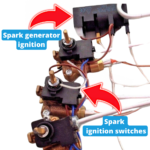 The ignition system 🎛️, responsible for transmitting information to the spark generator ⚡️, is typically one of two types. It may involve pressing a button 🔘 to initiate the spark ignition or holding down the gas valve knob 🔄 during lighting. This action activates the spark generator, sending the necessary spark to the burner cap 🔥. Regrettably, these switches may falter due to spillages 💦 or insufficient electrical connections 🔌 in certain instances.
The ignition system 🎛️, responsible for transmitting information to the spark generator ⚡️, is typically one of two types. It may involve pressing a button 🔘 to initiate the spark ignition or holding down the gas valve knob 🔄 during lighting. This action activates the spark generator, sending the necessary spark to the burner cap 🔥. Regrettably, these switches may falter due to spillages 💦 or insufficient electrical connections 🔌 in certain instances.
How a cooker top hob Flame Safety Device (FSD) work
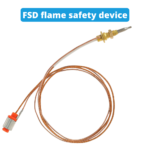 The Flame Safety Device (FSD) 🔥🔒 is engineered to permit a steady flow of gas ⛽ to the burner. Should the gas remain unlit 🔥🚫, the device will automatically shut off the gas valve 🔧, safeguarding against factors such as wind 🌬️ extinguishing the flame. By maintaining a minimum temperature 🌡️, the FSD ensures safety by cutting off the gas supply when required.
The Flame Safety Device (FSD) 🔥🔒 is engineered to permit a steady flow of gas ⛽ to the burner. Should the gas remain unlit 🔥🚫, the device will automatically shut off the gas valve 🔧, safeguarding against factors such as wind 🌬️ extinguishing the flame. By maintaining a minimum temperature 🌡️, the FSD ensures safety by cutting off the gas supply when required.
How a cooker top hob jet cup is configured with other components
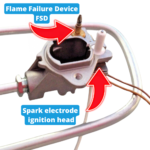 The burner cup 🥣, situated on the hob, receives gas ⛽ for the corresponding valve. Typically featuring one or multiple gas jets 🔥, it allows a mix of oxygen & gas to reach the burner head. Adjacent to the cup, you'll find the FSD (flame safety device) 🔥🔒 and spark electrode ⚡.
The burner cup 🥣, situated on the hob, receives gas ⛽ for the corresponding valve. Typically featuring one or multiple gas jets 🔥, it allows a mix of oxygen & gas to reach the burner head. Adjacent to the cup, you'll find the FSD (flame safety device) 🔥🔒 and spark electrode ⚡.
On top of this assembly, the burner head and cap are fitted – crucial components for blending oxygen and gas at the optimal rate to achieve the desired calorific power 🔥💨. Generally, this essential structure is bolted underneath the cooktop 🔩🍳.
How a cooker top hob gas valve works
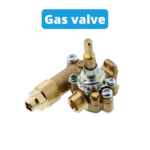 The hob's gas valve 🔧 links to the gas feed rail 🛤️, subsequently connecting to the property's gas supply ⛽. This valve not only modulates the gas quantity needed at the burner head 🔥, but occasionally serves as the ignition switch 🔘 for lighting the gas as well. It regulates the gas flow towards the burner head, with the Flame Safety Device (FSD) 🔥🔒 affixed to it.
The hob's gas valve 🔧 links to the gas feed rail 🛤️, subsequently connecting to the property's gas supply ⛽. This valve not only modulates the gas quantity needed at the burner head 🔥, but occasionally serves as the ignition switch 🔘 for lighting the gas as well. It regulates the gas flow towards the burner head, with the Flame Safety Device (FSD) 🔥🔒 affixed to it.
The FSD keeps a watchful eye 👀 on flame temperature 🌡️; should there be an absence of heat 🔥🚫, it promptly halts the gas supply passing through the valve 🛑⛽.
-
How to test oven elements out of cookers
-
How to Convert Natural Gas Cooker Oven Hob to Bottle Gas lpg, Butane, Propane, Calor Etc
-
Cooker Oven overheats and burns eveything
-
Cooker Oven fan motor is not working or spinning correctly slow or is noisy
-
Oven or Cooker Grill element doesn’t work or only part of it heats up
-
Oven trips Electricity Rcd or fuse on the main fuse board when you turn the cooker on
-
No Heat in Oven, Cooker not reaching temperature or cooking evenly
-
Cooker or Oven will not work after a power cut
Some of the gas products that we stock

